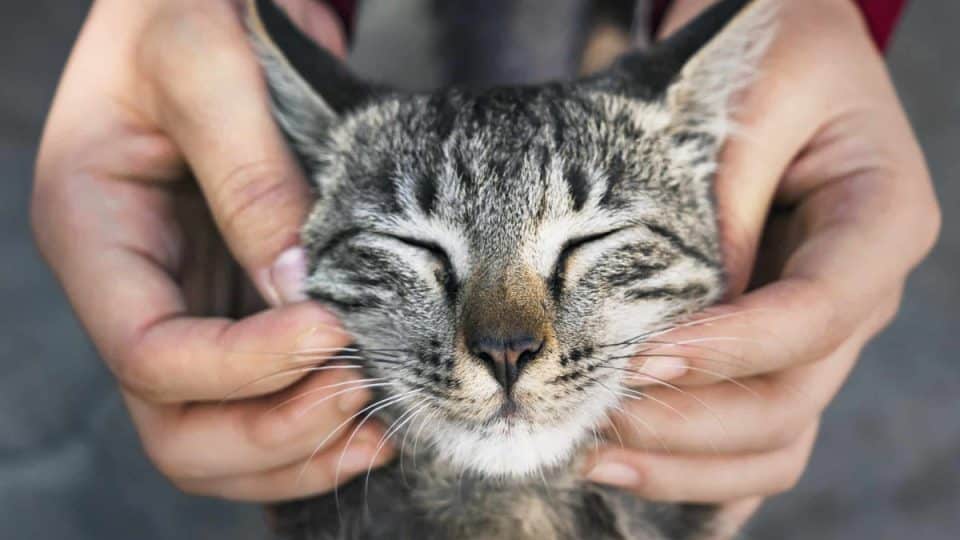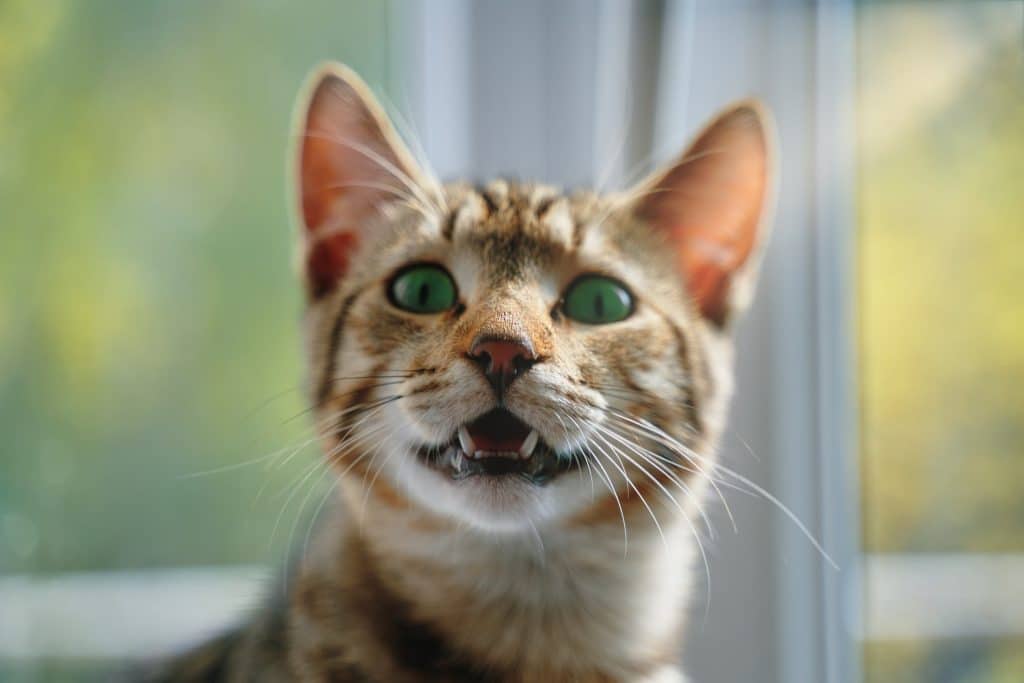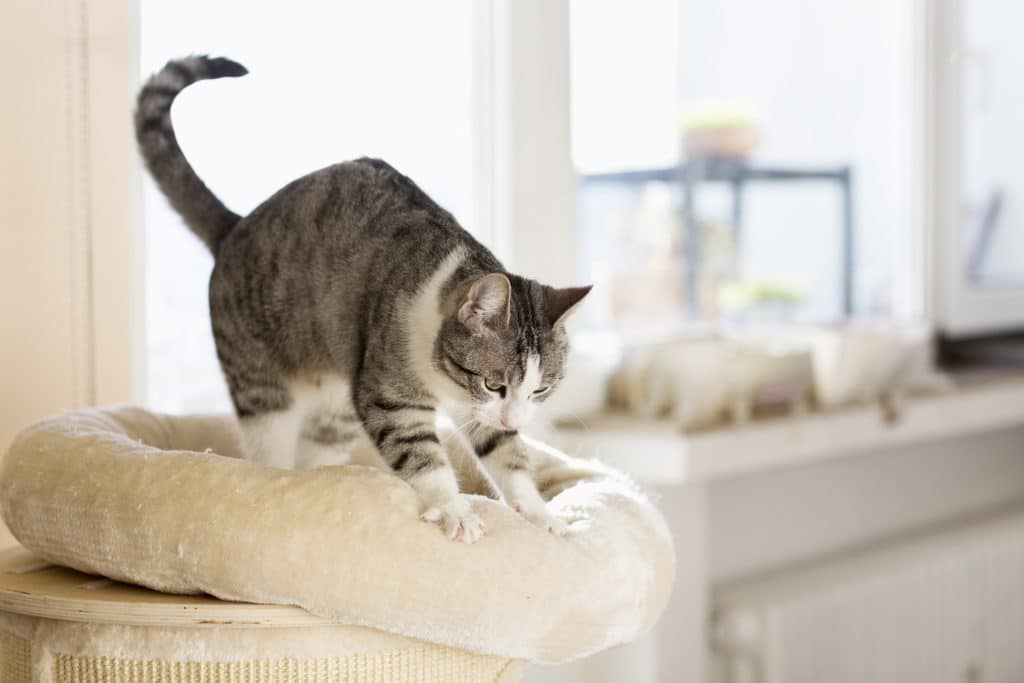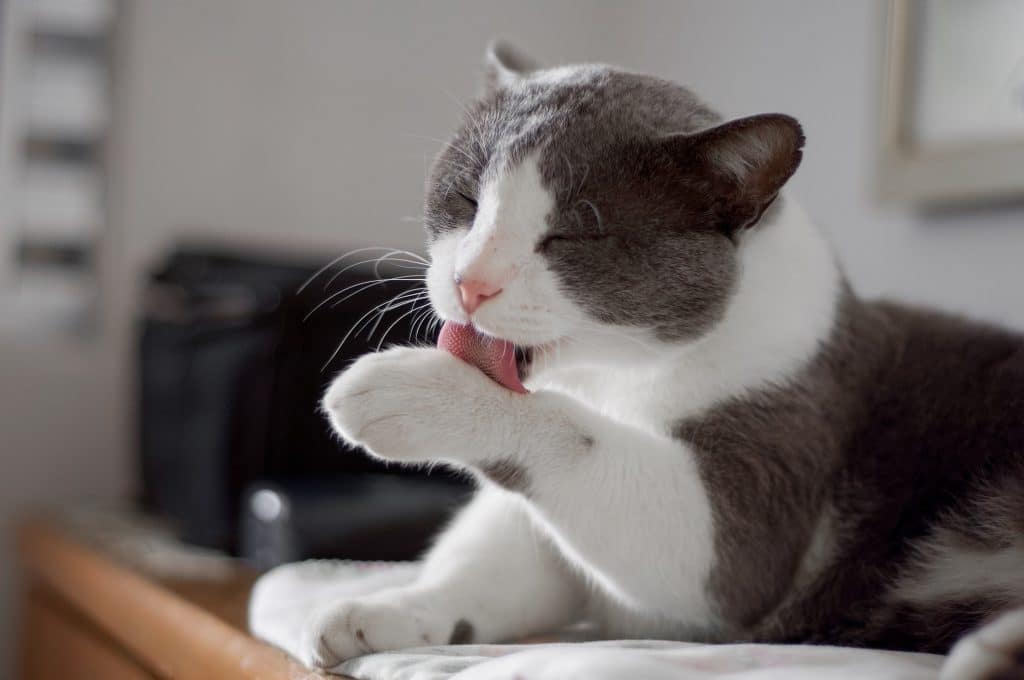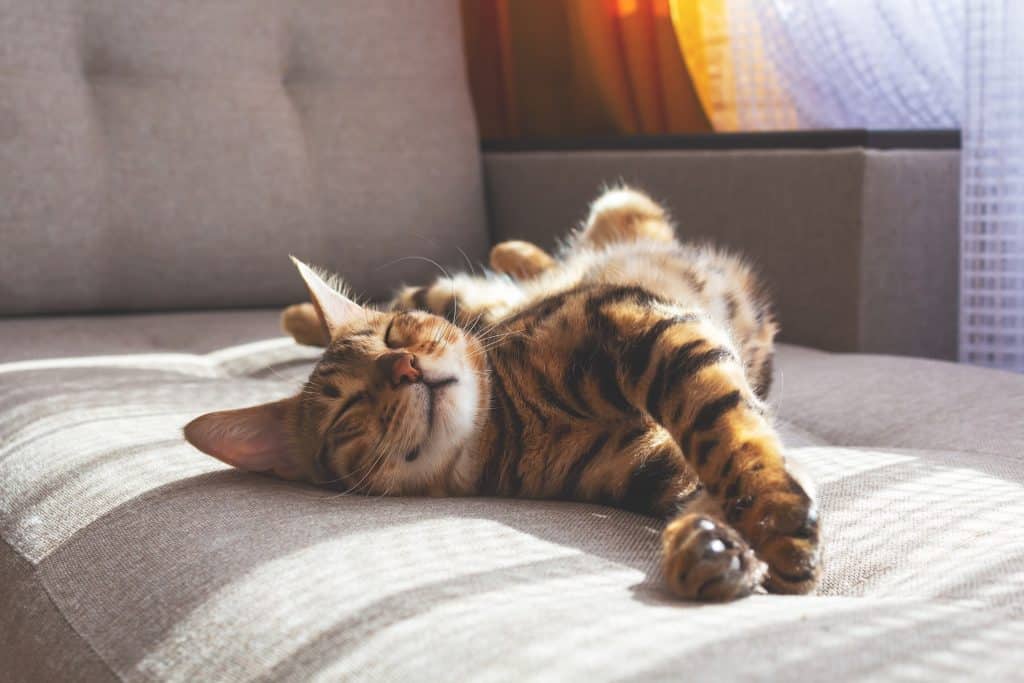- Not a substitute for professional veterinary help.
As pet parents, we always want to ensure our cats are living their best lives. But cats don’t experience and express emotions in the same ways that we do—or even in the same ways as dogs. So, how can you tell if your cat is happy?
“Happy cats are usually relaxed around their human and cat families, and they freely solicit interactions from them,” says Tom Kirby, a certified animal behavior consultant and founder of Kitty Help Desk. “[They] don’t run away when approached, and they display the enjoyment they receive from interactions through purring and reciprocal behaviors like head butting.”
From “making biscuits” to drooling, we share common signs of a happy cat. We also discuss whether or not cats need to go outside to be completely fulfilled and what to do if you think your cat is unhappy.
Signs Your Cat Is Happy with You
Signs of a happy cat include certain vocalizations, relaxed body language, and an increased desire to explore and play. Still not sure if you have a happy kitty at home? Experts say to look for these 10 signs.
Purring, chirping, and meowing
Happy cat sounds include purring when you pet your kitty or when they’re lounging. It’s not unusual for purring to kick into high gear when a cat is cuddling or kneading their paws on a soft surface, especially when that soft surface is their favorite human.
At times, your cat may even chirp like a bird when they’re sitting at their favorite window, watching birds or squirrels. That’s a hunter’s instinct coming to the fore.
While adult cats tend not to meow at each other, some cats will meow at their humans, says Baltimore-based cat behavior expert Laura Cassiday. High-pitched meows and meows that are greetings are especially cheerful. You might even find that your cat enjoys engaging in “a conversation” with you. However, a talkative cat isn’t always a happy cat. If your cat is meowing more than usual or acting differently, you’ll want to contact your vet.
-
iStock/Savusia Konstantin
Relaxed body movements
You can tell a lot about your kitty’s mood by reading cat body language. A cat that stretches out, flops over, and exposes their belly is a cat who’s telling you they feel safe and secure around you and in their environment. It may not be an invitation for a tummy rub, though!
Happy cat behavior also includes rubbing their faces and bodies on furniture and corners or even on you or other pets in the home. Cats do this to leave their scent but also to get your attention by being extra cute.
The loaf is another adorable cat pose that indicates a comfortable, relaxed kitty. In this position, cats tuck their front and back paws underneath their body, wrapping their tail around them, head upright.
Kneading
Kneading, aka “making biscuits,” is an adorable way your cat shows they’re cozy, winding down, or marking their territory. Cats knead to stretch their muscles. They also do it to “fluff up” their resting place, just like a pillow. They learn the behavior as a kitten, kneading milk out of their mother’s belly. As an adult, the action brings comfort and a sense of security.
Slow blinks and eye contact
While cats don’t outright smile, they do have expressions that act in a similar manner, like the slow blink. Sometimes called a “cat kiss,” this subtle but meaningful gesture is a deliberate behavior that your cat makes to show they’re content and calm being with their loved ones. Cats also slowly blink at other cats to extend trust and friendship.
Curiosity
Cats are built to explore, and a happy cat is often a curious cat. Confident kitties driven by their curiosity will be more likely to engage in interactive play with their human, other cats, or toys. They’ll also be more likely to investigate their environment, poking their noses into closets and cupboards and stuffing themselves into the tiniest of cardboard boxes. Conversely, stressed and fearful cats are more likely to hide and cautiously observe the world from a safe spot.
Playful and active
As mentioned above, happy cats are more active and eager to play. “Playing with your cat regularly—twice daily in the morning and evening—is highly recommended and is the best way to reduce stress,” Cassiday says.
Play, however, looks different for every cat, with age being a big factor. Kittens have boundless energy, climbing over everything, chasing and pouncing, biting and kicking, and wrestling and tumbling.
As cats mature and grow into adulthood, these actions typically transform into more deliberate and focused play that mimics parts of the hunting sequence, such as stalking, pouncing, and chasing (like trying to catch a laser pointer).
By the time a cat is a senior, play sessions are typically shorter and less intense to match their lower energy levels. For instance, happy senior play might look like gently batting, snuggling, or chewing a catnip toy.
-
iStock/SilviaJansen
- Drooling
Dogs aren’t the only ones who drool. Dribbling while making biscuits, relaxing, or being petted are all signs of a happy cat. Not all cats drool when they’re happy, though, so it’s okay if your happy kitty doesn’t. Drooling can also signify stress, fear, or illness, so pay close attention to context clues like body language and vocalizations.
Consistent eating, sleeping, and grooming routine
“The primary thing to look for in a happy cat is that they are comfortable performing their normal and natural behaviors,” Cassiday says. Sleeping, eating, and grooming habits vary among cats, with some sleeping as many as 20 hours and others as little as 12. Note what’s normal for your kitty, and talk to your vet if you spot any changes.
Upright or quivering tail
Cats use their tails to express how they feel. Happy cat tail signs include an upright tail, which is basically a cat’s way of saying, “Hi! Nice to see you!” A quivering tail pointed up and held high is also usually a declaration of happiness and excitement. This happy cat behavior is often paired with other actions like rubbing against your legs, enthusiastic head butts, and purring.
Affectionate
Cats are more solitary animals than dogs, but that doesn’t mean they aren’t social. A cat’s affection toward their humans and other cats varies, but a happy, well-socialized cat tends to be less timid or aggressive than a stressed-out cat.
A happy cat may show their affection by sleeping on you, curling up on your lap, licking you, or giving you a head butt. Cassiday also notes that cats in happy multi-cat households may play with each other, sleep next to or near each other, or engage in mutual grooming.
-
iStock/Caíque de Abreu
How the Litter Box Is Like a Mood Box
Litter box behavior often mirrors your cat’s mood. When cats are happy and healthy, they tend to use the litter box correctly.
Normal litter box habits include:
- Regularly peeing and regularly pooping in the litter box
- Entering and exiting the litter box with a loose and relaxed posture
- Digging and covering their poop normally
On the other hand, a stressed or anxious cat might:
- Avoid the litter box
- Have accidents and pee everywhere or poop outside the litter box
- Pee and poop more or less often
- Make loud or strained noises while using the litter box
If your usual happy cat suddenly changes their litter box habits, something in their environment might be stressing them out. Perhaps your household routine has changed, a guest is visiting, or you brought home a new cat. You’ll also want to see your vet to rule out any medical conditions.
Do Cats Need to Be Outside to Be Happy?
Not necessarily, says Kirby. “Most cats can be quite content living indoors as long as they’re actively stimulated by their environment and their family every day,” he adds.
Many indoor cats feel intimidated and even frightened by the outside world. “[Outdoor cats are] exposed to a lot more things that can cause stress, such as predators, traffic, illness and disease, and competition over food,” Cassiday says.
Cats that truly crave the outdoors will scratch at the door or windows, sit by the door, pace, or meow excessively. For these cats, there are many ways to still fulfill their needs. Here are a few ideas.
- Provide an enriching environment. Ensure your indoor cat has access to plenty of enriching items on a daily basis, such as a multi-tiered cat tree, scratching posts, window perches, cat-safe grasses, and puzzle toys. It can also be as simple as giving a box sprinkled with tantalizing catnip.
- Build a catio. Catios safely allow your cat to enjoy the sights and scents of the outdoors. Most catios are attached to the home via a cat door and range from elaborate structures to a small window-style seat.
- Play with your cat daily. Tossing a crinkle toy or flitting around a wand toy for your cat to chase gets out pent-up energy, meets instinctual needs, and strengthens the bond between you and your cat.
- Harness train your cat. If your cat is really itching to be outside, teach them how to be comfortable with a leash and harness and take them for a walk around the neighborhood.
-
iStock/Anna Derzhina
What If My Cat Is Unhappy?
If you just brought a cat home and aren’t sure yet if they enjoy your company, don’t despair. It may take a while for them to settle in and feel comfortable. It’s extremely common for new cats to act skittish and hide in a new environment. However, if this behavior continues after a few months without any progress, your cat may not be happy.
“Many unhappy cats will spend much of their time in hiding because their unhappiness is a response to fear, anxiety, and stress,” says Kirby.
Signs that a cat is unhappy include:
- Tail lashing or thumping
- Pinned ears
- Wide eyes with dilated pupils
- Swatting you away
- Biting
- Walking away or hiding
- Puffed-up fur or twitching skin
Loneliness
Cats are known for their independence, but they are social creatures who enjoy your company. Kitties who have a strong bond with their humans especially miss them when they’re gone and may feel lonely if they’re alone at home all day.
A few ways to tell if your cat is lonely include:
- Destructive behavior: knocking things over, scratching furniture, or chewing on non-food items.
- Waiting by the door for you
- Lack of appetite
- Withdrawal
- Increased meowing, yowling, or crying
- Excessive grooming to self-soothe
Understimulation
Happy cats need plenty of physical and mental engagement. When they don’t have enough stimulation in their lives, they can become bored and frustrated. Cats can manifest their boredom in various ways, sometimes subtly and sometimes more pronounced. Knowing what to look for will ensure your cat has a healthy and fulfilled life.
Signs your cat is understimulated include:
- Spraying
- Scratching and chewing things in the house
- Overgrooming
- Overeating
- Excessive sleeping
- Increased aggression and irritability
- Obsessive behaviors like chasing their tail, pacing, and excessive licking
Anxiety
Some cats experience situational stress, while others are more prone to anxiety because of a lack of socialization, medical issues, or past traumatic experiences like neglect or being in a car accident. Other cats may also experience separation anxiety when separated from their pet parent.
Common signs of cat anxiety include:
- Flattened ears, dilated pupils, tucked tail
- Appetite loss
- Litterbox avoidance
- Excessive vocalization
- Changes in sleep
- Overgrooming
- Hiding or withdrawal
- Trembling or shaking
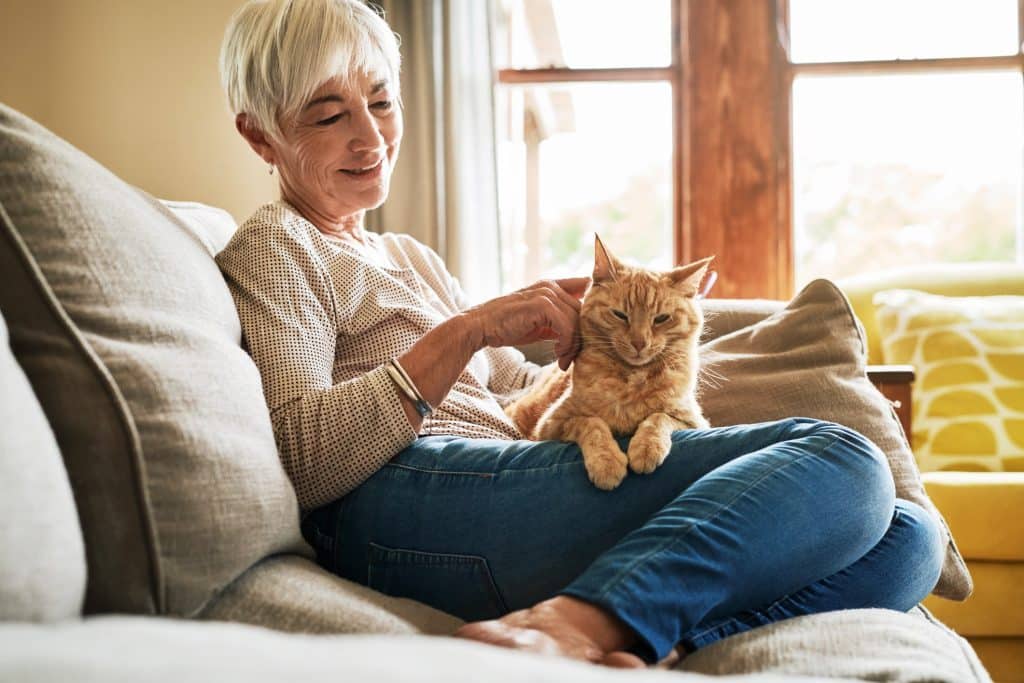
iStock/Dean Mitchell
Solutions
If your cat is unhappy, there are some things you can do to lift their mood. Along with enhancing their environment and playing with them, here are a few other options.
- Talk to your cat. Research shows that cats understand when we speak to and about them, so a chat is a great way to strengthen your bond.
- Treat and train them. Show your kitty some love with a tasty tidbit just because. Or use high-value treats to clicker train certain behaviors or tricks.
- Keep your cat clean and well-groomed. Brushing your cat replicates communal grooming, or allogrooming, an essential tool for bonding.
- Keep your cat’s environment clean. Scoop litter boxes daily and thoroughly clean them every 10 to 14 days.
- Provide adequate food and water. Water fountains and automatic feeders make it easy when you’re on the go.
- Work with a cat behaviorist. Experts can assess your cat’s needs, identify stressors, and create a personalized plan for your kitty to live his happiest life.
